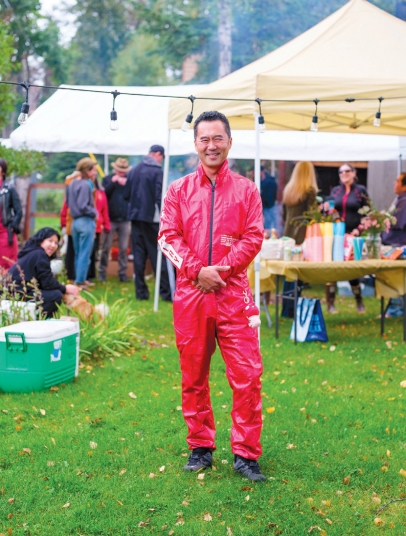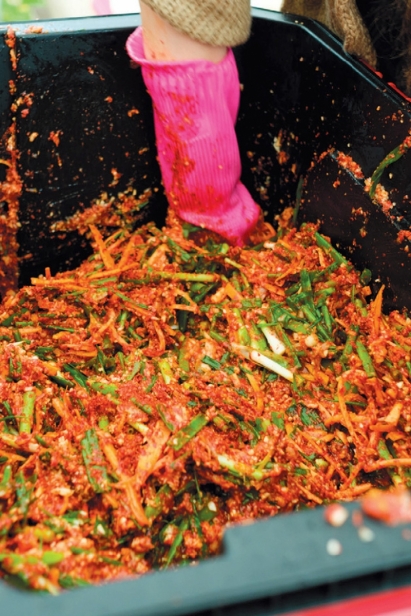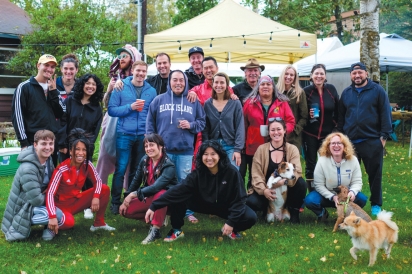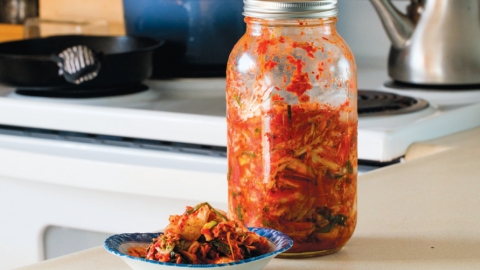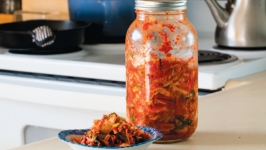Yardy Hard for Kimchi
Drive down Fireweed Lane in Anchorage, a longtime artery in a neighborhood full of Korean-owned businesses. Pass the Oriental Shopping Center and the Wonjo Tofu House, Good News Anchorage Church, and the Korean Rice Cake shop. Wind through the neighborhood to a shady corner and the low-slung house there. This is Jae Shin’s place, and the venue for his annual winter kimchi “yardy.”
By noon his yard is partly covered in tents, birch leaves swirling noon his yard is partly cove down. His friends—many of them local chefs and restaurant workers—crowd around tables, chop onions and daikon, julienne carrots. A large plastic tote holds 105 pounds of chopped napa cabbage, wet with water and sprinkled with salt.
Shin, who works as an architect, immigrated with his mother to Anchorage in 1976 at age 5, from Incheon, in the northern part of South Korea, during a time when many people were leaving due to tough economic conditions. His mom followed a school friend to Alaska, he said. His kimchi recipe is part hers, and part his, and meant to contain the specific flavors of the place where he was born.
“You know how parents are. They never have the recipe. It’s kind of like, ‘A little bit of this, a little bit of that,’” Shin said. “This recipe is kind of a mash-up. I had to do just a bit of my mom’s sort of stuff, and then just look online, trying to figure out a northern style.”
His recipe uses napa cabbage, carrots, daikon, onions, Korean red pepper powder or gochugaru, and green onions with lots of garlic and ginger. A paste of rice flour, sugar, and Sprite fuels its ferment. Sometimes he adds fermented salted shrimp. In the southern part of South Korea, some kimchi also contains anchovy powder, and whole crab or oysters to increase the funkiness, he said.
After Shin and his mom came to Anchorage, she started and ran Soo’s Custom Tailoring in the Spenard neighborhood for 20 years. After he graduated from West Anchorage High School, he started making his own kimchi in college while studying at Rhode Island School of Design because he craved the tartness and the burst of endorphins that came with the heat.
In Korea, kimchi is traditionally made by women, always in quantity, he said. He remembers his aunts making it, and he has ten of them.
“When you make kimchi, you make a big vat because it’s like ta-males, right? You don’t make two tamales; you make as many as you can,” he said.
Shin’s yard fills with more friends. The mood is festive. Some people have come dressed in bright jumpsuits, a nod to Korean K-pop style. The host lights a fire. A deejay arrives. A table fills with potluck foods— lots of types of kimchi, perilla leaves, rice, kim bob or Korean sushi, prepared vegetables called ban chan from the nearby New Central Market. Shin and friends rinse the cabbage. Wearing pink rubber gloves, he mixes in gochugaru (chili powder), rice flour paste, and vegetables. Kimchi has grown in popularity in Alaska since Shin was a kid, he said. It is even eaten on the North Slope, with whale, thanks to the influence of Korean immigrants who arrived about the time his mother did.
No matter the culture, people have always gathered like this, doing the labor of food preparation, he said. “Food brings people together.”
As the sun sets, the friends pack jars under the glow of white Christmas lights. Shin takes a break under the tent, sporting his red K-pop jumpsuit and pink gloves, taking in the scene: deejay beats, dogs, friends, and jars of kimchi in a row. No matter the culture, people have always gathered like this, doing the labor of food preparation, he said. “Food brings people together.”
Here are some tips for making his recipe: you’ll need a spray bottle and rubber gloves. For best results, avoid eating directly from the jar, as introducing more oxygen can make the kimchi age faster. If the kimchi becomes overly fermented, consider making a kimchi stew. There are plenty of recipes available online. Feel free to experiment with the ingredients, such as using only daikon or adding more carrots. Once you have it dialed in, throw a party. Invite everyone to help. Make enough kimchi for a happy army of friends.


